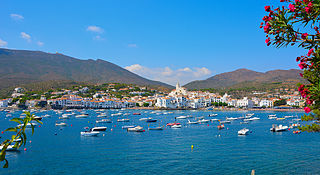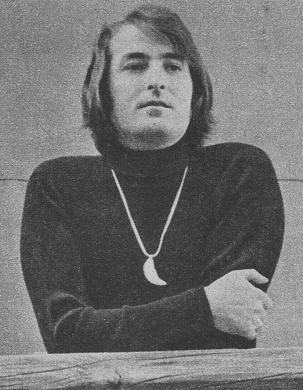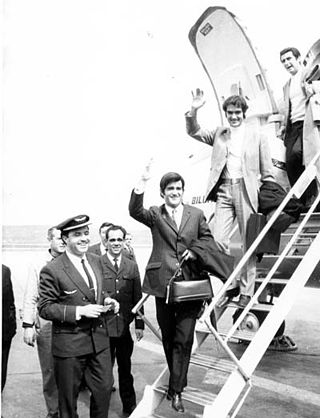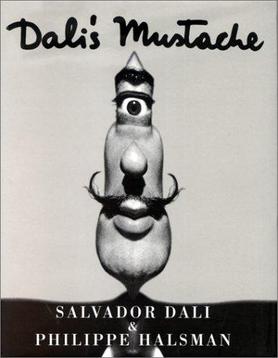Related Research Articles

Salvador Domingo Felipe Jacinto Dalí i Domènech, Marquess of Dalí of Púbol, known as Salvador Dalí, was a Spanish surrealist artist renowned for his technical skill, precise draftsmanship, and the striking and bizarre images in his work.

The culture of Argentina is as varied as the country geography and is composed of a mix of ethnic groups. Modern Argentine culture has been influenced largely by the Spanish colonial period and the 19th/20th century European immigration, and also by Amerindian culture, particularly in the fields of music and art. Buenos Aires, its cultural capital, is largely characterized by both the prevalence of people of Southern European descent, and of European styles in architecture. Museums, cinemas, and galleries are abundant in all of the large urban centers, as well as traditional establishments such as literary bars, or bars offering live music of a variety of music genres.
The Music of Nicaragua contains a mixture of European, Indigenous, and African influences. Occasionally, it also rarely features Asian and Arab musical influences as well as from other countries of Hispanic and Latino origin. Musical instruments include the marimba and others that are common across Central America. Pop music includes performers from all around the world including Nicaraguans, Cubans, Brazilians, Mexicans, Panamanians, as well as those from Europe and the United States.

Cadaqués is a town in the Alt Empordà comarca, in the province of Girona, Catalonia, Spain. It is on a bay in the middle of the Cap de Creus peninsula, near Cap de Creus cape, on the Costa Brava of the Mediterranean. It is two-and-a-quarter-hour drive from Barcelona, and thus it is accessible not only to tourists but also to people who want a second home for weekends and summers. In 2002, Cadaqués had an official population of 2,612, but up to ten times as many people can live in the town during the peak of the summer tourism season.

Luis Manuel Ferri Llopis, better known by his stage name Nino Bravo, was a Spanish baroque pop and ballad singer.

Maná is a Mexican pop-rock band. Formed in 1981 as Sombrero Verde, the current lineup consists of vocalist/guitarist Fher Olvera, drummer Alex González, guitarist Sergio Vallín and bassist Juan Calleros. The band is considered one of the best-selling Latin music artists and the most successful Latin American band of all time with over 25 million records sold worldwide. Maná has moreover earned four Grammy Awards, eight Latin Grammy Awards, five MTV Video Music Awards Latin America, six Premios Juventud awards, 19 Billboard Latin Music Awards, and 15 Premios Lo Nuestro awards.

The Great Masturbator (1929) is a painting by Salvador Dalí executed during the surrealist epoch, and is currently displayed at Museo Nacional Centro de Arte Reina Sofía, Madrid.
Rock and roll music was introduced in Cuba in the late 1950s, with many Cuban artists of the time covering American songs translated into Spanish, as was occurring in Mexico at the same time. "The Batista police never looked kindly on Rock and Roll, and much less after the screening of films like Rebel Without a Cause and The Bad Seed, among others. After 1959, Rock and Roll followed the same path, although artists like Argentinean Luis Aguile emerged."

The 5th Annual Latin Grammy Awards were held on Wednesday, September 1, 2004, at the Shrine Auditorium in Los Angeles.
Mexican pop is a music genre produced in Mexico, particularly intended for teenagers and young adults.
Luis García Mozos is a Spanish comic book artist.

América & en Vivo is a live extended play (EP) by Mexican singer Luis Miguel. It was released on 25 September 1992 by WEA Latina. The EP consists of three live versions of "Inolvidable", No Sé Tú", and "Contigo en la Distancia" from his performance at the National Auditorium in Mexico during his Romance Tour on June 26, 1992, as well as a new track "America, America", originally performed by Nino Bravo. "America, America" was released as a single and peaked at number 20 on the Billboard Hot Latin Songs chart. The EP was rated three out of five stars by an editor on AllMusic and received a positive review from Mario Taradell of the Miami Herald, who praised his vocals and the production of the EP. América & En Vivo peaked at number 12 on the Billboard Latin Pop Albums chart and was certified platinum in Argentina by the Argentine Chamber of Phonograms and Videograms Producers (CAPIF).

Dúo Dinámico is a Spanish pop music duo formed by Manuel de la Calva and Ramón Arcusa. Besides singers, they are songwriters and record producers and they starred in four feature films. They were the main precursors of pop music and fandom in Spain and were very popular in the 1960s.
Spain took part in the Eurovision Song Contest 1971. The country was represented by Karina with the song "En un mundo nuevo". Karina was selected through the competition Pasaporte a Dublín, and the song she would sing in Dublin was internally chosen once the national final was over. The music was composed by Rafael Trabucchelli and the lyrics written by Tony Luz.
Latin ballad is a sentimental ballad derived from bolero that originated in the early 1960s in Los Angeles, California and Southern California.
Martin J. Louis is a Spanish photographer and painter best known for his iconic shots of rock and roll legends such as Queen, David Bowie, Robert Plant, Lou Reed, Ozzy Osbourne and Pink Floyd.

El ministerio del tiempo is a Spanish fantasy television series created by Javier and Pablo Olivares and produced by Onza Partners and Cliffhanger for Televisión Española (TVE). It premiered on 24 February 2015 on TVE's main channel La 1. The series follows the exploits of an investigative team in the fictional Ministry of Time, which deals with incidents caused by time travel that can cause changes to the present day.

Dali's Mustache is an absurdist humorous book by the surrealist artist Salvador Dalí (1904–1989) and his friend, the photographer Philippe Halsman (1906–1979). The first edition was published in October 1954 in New York; slightly modified French editions followed in the 1980s and 1990s.

"América América" is a song written by José Luis Armenteros and Pablo Herrero and performed by Spanish performer Nino Bravo. It was released as a single for his fifth studio album y volumen 5 (1973). The song reached number one on the Spanish Singles Chart in 1973. In 2013, the song was inducted into the Latin Grammy Hall of Fame.
References
- ↑ "Entrevista a Martin J. Louis". Nino Bravo. Retrieved 12 May 2015.
- ↑ "40 años de Popular 1". elmundo.es. Retrieved 12 May 2015.
- ↑ "El Bibliófilo Enmascarado". bibliofiloenmascarado. Retrieved 12 May 2015.
- ↑ "GENE SIMMONS ES PORTADA DEL 'POPULAR 1 MAGAZINE', ESPAÑA". Kiss Army Spain. Retrieved 12 May 2015.
- ↑ "Unseen Photos of Rock Stars and Salvador Dali Revealed (PHOTOS)". The Huffington Post. Retrieved 12 May 2015.
- ↑ "From Led Zeppelin to Queen, Martin Frias' aim was true". Access Atlanta. Retrieved 12 May 2015.